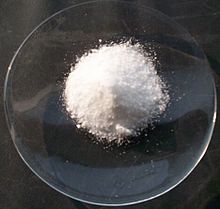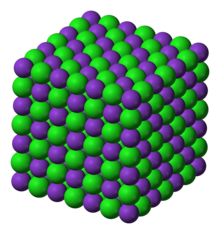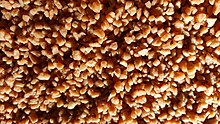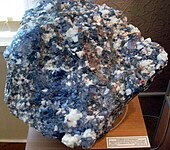 | |
 | |
| Names | |
|---|---|
Other names
| |
| Identifiers | |
| CAS Number | |
| 3D model (JSmol) | |
| ChEBI | |
| ChEMBL | |
| ChemSpider | |
| DrugBank | |
| ECHA InfoCard | 100.028.374 |
| E number | E508 (acidity regulators, ...) |
| KEGG | |
| PubChem CID | |
| RTECS number |
|
| UNII | |
| CompTox Dashboard (EPA) | |
InChI
| |
SMILES
| |
| Properties | |
| Chemical formula | KCl |
| Molar mass | 74.555 g·mol |
| Appearance | white crystalline solid |
| Odor | odorless |
| Density | 1.984 g/cm |
| Melting point | 770 °C (1,420 °F; 1,040 K) |
| Boiling point | 1,420 °C (2,590 °F; 1,690 K) |
| Solubility in water | 27.77 g/100mL (0 °C) 33.97 g/100mL (20 °C) 54.02 g/100mL (100 °C) |
| Solubility | Soluble in glycerol, alkalies Slightly soluble in alcohol Insoluble in ether |
| Solubility in ethanol | 0.288 g/L (25 °C) |
| Acidity (pKa) | ~7 |
| Magnetic susceptibility (χ) | −39.0·10 cm/mol |
| Refractive index (nD) | 1.4902 (589 nm) |
| Structure | |
| Crystal structure | face centered cubic |
| Space group | Fm3m, No. 225 |
| Lattice constant | a = 629.2 pm |
| Coordination geometry | Octahedral (K) Octahedral (Cl) |
| Thermochemistry | |
| Std molar entropy (S298) |
83 J·mol·K |
| Std enthalpy of formation (ΔfH298) |
−436 kJ·mol |
| Pharmacology | |
| ATC code | A12BA01 (WHO) B05XA01 (WHO) |
| Routes of administration |
Oral, IV, IM |
| Pharmacokinetics: | |
| Excretion | Kidney: 90%; Fecal: 10% |
| Hazards | |
| NFPA 704 (fire diamond) |
 |
| Flash point | Non-flammable |
| Lethal dose or concentration (LD, LC): | |
| LD50 (median dose) | 2600 mg/kg (oral, rat) |
| Safety data sheet (SDS) | ICSC 1450 |
| Related compounds | |
| Other anions | Potassium fluoride Potassium bromide Potassium iodide |
| Other cations | Lithium chloride Sodium chloride Rubidium chloride Caesium chloride Ammonium chloride |
| Related compounds | Potassium hypochlorite Potassium chlorite Potassium chlorate Potassium perchlorate |
| Except where otherwise noted, data are given for materials in their standard state (at 25 °C , 100 kPa).
| |
Potassium chloride (KCl, or potassium salt) is a metal halide salt composed of potassium and chlorine. It is odorless and has a white or colorless vitreous crystal appearance. The solid dissolves readily in water, and its solutions have a salt-like taste. Potassium chloride can be obtained from ancient dried lake deposits. KCl is used as a fertilizer, in medicine, in scientific applications, domestic water softeners (as a substitute for sodium chloride salt), and in food processing, where it may be known as E number additive E508.
It occurs naturally as the mineral sylvite, which is named after salt's historical designations sal degistivum Sylvii and sal febrifugum Sylvii, and in combination with sodium chloride as sylvinite.
Uses
Fertilizer

The majority of the potassium chloride produced is used for making fertilizer, called potash, since the growth of many plants is limited by potassium availability. The term "potash" refers to various mined and manufactured salts that contain potassium in water-soluble form. Potassium chloride sold as fertilizer is known as "muriate of potash"—it is the common name for potassium chloride (KCl) used in agriculture. The vast majority of potash fertilizer worldwide is sold as muriate of potash. The dominance of muriate of potash in the fertilizer market is due to its high potassium content (approximately 60% K
2O equivalent) and relative affordability compared to other potassium sources like sulfate of potash (potassium sulfate). Potassium is one of the three primary macronutrients essential for plant growth, alongside nitrogen and phosphorus. Potassium plays a vital role in various plant physiological processes, including enzyme activation, photosynthesis, protein synthesis, and water regulation. For watering plants, a moderate concentration of potassium chloride (KCl) is used to avoid potential toxicity: 6 mM (millimolar) is generally effective and safe for most plants, that is approximately 0.4 grams (0.014 oz) per liter of water.
Medical use
Main article: Potassium chloride (medical use)Potassium is vital in the human body, and potassium chloride by mouth is the standard means to treat low blood potassium, although it can also be given intravenously. It is on the World Health Organization's List of Essential Medicines. It is also an ingredient in Oral Rehydration Therapy (ORT)/solution (ORS) to reduce hypokalemia caused by diarrhoea. This is another medicine on the WHO's List of Essential Medicines.
Potassium chloride contains 52% of elemental potassium by mass.
Overdose causes hyperkalemia which can disrupt cell signaling to the extent that the heart will stop, reversibly in the case of some open heart surgeries.
Culinary use
Potassium chloride can be used as a salt substitute for food, but due to its weak, bitter, unsalty flavor, it is often mixed with ordinary table salt (sodium chloride) to improve the taste, to form low sodium salt. The addition of 1 ppm of thaumatin considerably reduces this bitterness. Complaints of bitterness or a chemical or metallic taste are also reported with potassium chloride used in food.
Execution
In the United States, potassium chloride is used as the final drug in the three-injection sequence of lethal injection as a form of capital punishment. It induces cardiac arrest, ultimately killing the inmate.
Industrial
| This section needs additional citations for verification. Please help improve this article by adding citations to reliable sources in this section. Unsourced material may be challenged and removed. (September 2022) (Learn how and when to remove this message) |
As a chemical feedstock, the salt is used for the manufacture of potassium hydroxide and potassium metal. It is also used in medicine, lethal injections, scientific applications, food processing, soaps, and as a sodium-free substitute for table salt for people concerned about the health effects of sodium.
It is used as a supplement in animal feed to boost the potassium level in the feed. As an added benefit, it is known to increase milk production.
It is sometimes used in solution as a completion fluid in petroleum and natural gas operations, as well as being an alternative to sodium chloride in household water softener units.
Glass manufacturers use granular potash as a flux, lowering the temperature at which a mixture melts. Because potash imparts excellent clarity to glass, it is commonly used in eyeglasses, glassware, televisions, and computer monitors.
Because natural potassium contains a tiny amount of the isotope potassium-40, potassium chloride is used as a beta radiation source to calibrate radiation monitoring equipment. It also emits a relatively low level of 511 keV gamma rays from positron annihilation, which can be used to calibrate medical scanners.
Potassium chloride is used in some de-icing products designed to be safer for pets and plants, though these are inferior in melting quality to calcium chloride. It is also used in various brands of bottled water.
Potassium chloride was once used as a fire extinguishing agent, and in portable and wheeled fire extinguishers. Known as Super-K dry chemical, it was more effective than sodium bicarbonate-based dry chemicals and was compatible with protein foam. This agent fell out of favor with the introduction of potassium bicarbonate (Purple-K) dry chemical in the late 1960s, which was much less corrosive, as well as more effective. It is rated for B and C fires.
Along with sodium chloride and lithium chloride, potassium chloride is used as a flux for the gas welding of aluminium.
Potassium chloride is also an optical crystal with a wide transmission range from 210 nm to 20 μm. While cheap, KCl crystals are hygroscopic. This limits its application to protected environments or short-term uses such as prototyping. Exposed to free air, KCl optics will "rot". Whereas KCl components were formerly used for infrared optics, they have been entirely replaced by much tougher crystals such as zinc selenide.
Potassium chloride is used as a scotophor with designation P10 in dark-trace CRTs, e.g. in the Skiatron.
Toxicity
The typical amounts of potassium chloride found in the diet appear to be generally safe. In larger quantities, however, potassium chloride is toxic. The LD50 of orally ingested potassium chloride is approximately 2.5 g/kg, or 190 grams (6.7 oz) for a body mass of 75 kilograms (165 lb). In comparison, the LD50 of sodium chloride (table salt) is 3.75 g/kg.
Intravenously, the LD50 of potassium chloride is far smaller, at about 57.2 mg/kg to 66.7 mg/kg; this is found by dividing the lethal concentration of positive potassium ions (about 30 to 35 mg/kg) by the proportion by mass of potassium ions in potassium chloride (about 0.52445 mg K/mg KCl).
Chemical properties
Solubility
KCl is soluble in a variety of polar solvents.
| Solvent | Solubility (g/kg of solvent at 25 °C) |
|---|---|
| Water | 360 |
| Liquid ammonia | 0.4 |
| Liquid sulfur dioxide | 0.41 |
| Methanol | 5.3 |
| Ethanol | 0.37 |
| Formic acid | 192 |
| Sulfolane | 0.04 |
| Acetonitrile | 0.024 |
| Acetone | 0.00091 |
| Formamide | 62 |
| Acetamide | 24.5 |
| Dimethylformamide | 0.17–0.5 |
Solutions of KCl are common standards, for example for calibration of the electrical conductivity of (ionic) solutions, since KCl solutions are stable, allowing for reproducible measurements. In aqueous solution, it is essentially fully ionized into solvated K and Cl ions.
Redox and the conversion to potassium metal
Although potassium is more electropositive than sodium, KCl can be reduced to the metal by reaction with metallic sodium at 850 °C because the more volatile potassium can be removed by distillation (see Le Chatelier's principle):
This method is the main method for producing metallic potassium. Electrolysis (used for sodium) fails because of the high solubility of potassium in molten KCl.
Other potassium chloride stoichiometries
Potassium chlorides with formulas other than KCl have been predicted to become stable under pressures of 20 GPa or more. Among these, two phases of KCl3 were synthesized and characterized. At 20-40 GPa, a trigonal structure containing K and Cl3 is obtained; above 40 GPa this gives way to a phase isostructural with the intermetallic compound Cr3Si.
Physical properties

Under ambient conditions, the crystal structure of potassium chloride is like that of NaCl. It adopts a face-centered cubic structure known as the B1 phase with a lattice constant of roughly 6.3 Å. Crystals cleave easily in three directions. Other polymorphic and hydrated phases are adopted at high pressures.
Some other properties are
- Transmission range: 210 nm to 20 μm
- Transmittivity = 92% at 450 nm and rises linearly to 94% at 16 μm
- Refractive index = 1.456 at 10 μm
- Reflection loss = 6.8% at 10 μm (two surfaces)
- dN/dT (expansion coefficient)= −33.2×10/°C
- dL/dT (refractive index gradient)= 40×10/°C
- Thermal conductivity = 0.036 W/(cm·K)
- Damage threshold (Newman and Novak): 4 GW/cm or 2 J/cm (0.5 or 1 ns pulse rate); 4.2 J/cm (1.7 ns pulse rate Kovalev and Faizullov)
As with other compounds containing potassium, KCl in powdered form gives a lilac flame.
Production


Potassium chloride is extracted from minerals sylvite, carnallite, and potash. It is also extracted from salt water and can be manufactured by crystallization from solution, flotation or electrostatic separation from suitable minerals. It is a by-product of the production of nitric acid from potassium nitrate and hydrochloric acid.
Most potassium chloride is produced as agricultural and industrial-grade potash in Saskatchewan, Canada, Russia, and Belarus. Saskatchewan alone accounted for over 25% of the world's potash production in 2017.
Laboratory methods
Potassium chloride is inexpensively available and is rarely prepared intentionally in the laboratory. It can be generated by treating potassium hydroxide (or other potassium bases) with hydrochloric acid:
This conversion is an acid-base neutralization reaction. The resulting salt can then be purified by recrystallization. Another method would be to allow potassium to burn in the presence of chlorine gas, also a very exothermic reaction:
References
- "Potassium chloride (PIM 430)". International Programme on Chemical Safety. 3.3.1 Properties of the substance. Archived from the original on 2010-12-04. Retrieved 2011-01-17.
- "periodic-table-of-elements.org". Archived from the original (website shows values in g/100ml) on 29 October 2020. Retrieved 4 October 2019.
- Sirdeshmukh DB, Sirdeshmukh L, Subhadra KG (2001). Alkali Halides: A Handbook of Physical Properties. Berlin: Springer. ISBN 978-3-540-42180-1.
- ^ Zumdahl SS (2009). Chemical Principles 6th Ed. Houghton Mifflin Company. p. A22. ISBN 978-0-618-94690-7.
- "Compound Summary for Potassium Chloride". PubChem. U.S. National Library of Medicine. CID 4873. Archived from the original on 2 August 2023. Retrieved 17 October 2015.
- Chambers M. "7447-40-7 - WCUXLLCKKVVCTQ-UHFFFAOYSA-M - Potassium chloride [USP:JAN]". ChemIDplus. U.S. National Library of Medicine. Archived from the original on 15 July 2015. Retrieved 22 December 2017.
- Rayner-Canham G, Overton T (22 December 2013). Descriptive inorganic chemistry (Sixth ed.). New York, NY: W. H. Freeman. ISBN 978-1-4641-2557-7. OCLC 882867766.
- "Potassium Fertilizers (Penn State Agronomy Guide)". Penn State Agronomy Guide (Penn State Extension). Archived from the original on 2016-12-20. Retrieved 2016-12-10.
- Watts, Henry (1883). A Dictionary of Chemistry and the Allied Branches of Other Sciences. Longmans, Green, and Company.
- ^ Burkhardt ER (2006). "Potassium and Potassium Alloys". Ullmann's Encyclopedia of Industrial Chemistry. doi:10.1002/14356007.a22_031.pub2. ISBN 978-3-527-30673-2.
- Weil, Ray; Brady, Nyle (2022). The Nature and Properties of Soils. Pearson Education. ISBN 978-93-5606-271-9.
- Manning, David A.C. (2010). "Mineral sources of potassium for plant nutrition. A review". Agronomy for Sustainable Development. 30 (2): 281–294. Bibcode:2010AgSD...30..281M. doi:10.1051/agro/2009023.
- Havlin, John L.; Tisdale, Samuel L.; Nelson, Werner L.; Beaton, James D. (2016). Soil Fertility and Fertilizers: An Introduction to Nutrient Management. Pearson. ISBN 978-93-325-7034-4.
- Nutrient Source Specifics: Potassium Chloride. Ref. No. 17 #13075 (PDF). International Plant Nutrition Institute (IPNI). Archived (PDF) from the original on 2024-04-14. Retrieved 2024-11-24.
- Havlin, John L.; Tisdale, Samuel L.; Nelson, Werner L.; Beaton, James D. (2014). "Potassium". Soil Fertility and Fertilizers (8th ed.). Pearson Education. pp. 186–188. ISBN 978-0-13-503373-9.
- ^ Manning, David A. C. (2010). "Mineral sources of potassium for plant nutrition. A review". Agronomy for Sustainable Development. 30 (2): 281–294. Bibcode:2010AgSD...30..281M. doi:10.1051/agro/2009023. Archived from the original on 2024-02-28. Retrieved 2024-11-24.
- Mineral Commodity Summaries: Potash (PDF). United States Geological Survey (USGS). U.S. Department of the Interior. Archived (PDF) from the original on 2024-11-12. Retrieved 2024-11-24.
- "Fertilizer Use by Crop". FAO Fertilizer and Plant Nutrition Bulletin. Food and Agriculture Organization of the United Nations. Archived from the original on 2024-09-02. Retrieved 2024-11-24.
- Roy, Ram N.; Finck, Arnold; Blair, Graeme J.; Tandon, H.L.S. (2006). Plant Nutrition for Food Security: A Guide for Integrated Nutrient Management. FAO Fertilizer and Plant Nutrition Bulletin 16. Food and Agriculture Organization of the United Nations. pp. 141–142. ISBN 92-5-105490-8. Archived from the original on 2023-01-02. Retrieved 2024-11-24.
- Brady, Nyle C.; Weil, Ray R. (2016). "Plant Nutrients and Nutrient Uptake". The Nature and Properties of Soils (15th ed.). Pearson Education. pp. 594–595. ISBN 978-0-13-325448-8.
- Römheld, Volker; Kirkby, Ernest A. (2010). "Research on potassium in agriculture: needs and prospects". Plant and Soil. 335 (1): 155–180. Bibcode:2010PlSoi.335..155R. doi:10.1007/s11104-010-0520-1. Archived from the original on 2024-07-09. Retrieved 2024-11-24.
- Xu, Xinxiang; Du, Xin; Wang, Fen; Sha, Jianchuan; Chen, Qian; Tian, Ge; Zhu, Zhanling; Ge, Shunfeng; Jiang, Yuanmao (2020). "Effects of Potassium Levels on Plant Growth, Accumulation and Distribution of Carbon, and Nitrate Metabolism in Apple Dwarf Rootstock Seedlings". Frontiers in Plant Science. 11: 904. doi:10.3389/fpls.2020.00904. PMC 7325393. PMID 32655607.
- Chen, Yuhang; Yu, Manman; Zhu, Zaibiao; Zhang, Lixia; Guo, Qiaosheng (2013). "Optimisation of Potassium Chloride Nutrition for Proper Growth, Physiological Development and Bioactive Component Production in Prunella vulgaris L". PLOS ONE. 8 (7): e66259. Bibcode:2013PLoSO...866259C. doi:10.1371/journal.pone.0066259. PMC 3706589. PMID 23874390.
- ^ World Health Organization (2019). World Health Organization model list of essential medicines: 21st list 2019. Geneva: World Health Organization. hdl:10665/325771. WHO/MVP/EMP/IAU/2019.06. License: CC BY-NC-SA 3.0 IGO.
- World Health Organization; Unicef (2006). Oral rehydration salts: production of the new ORS (PDF). WHO/FCH/CAH/06.1. hdl:10665/69227. Archived (PDF) from the original on 2023-06-03. Retrieved 2024-11-14.
- Zakiah, K.; Maulana, M. R.; Widowati, L. R.; Mutakin, J. (2021). "Applications of guano and K2CO3 on soil potential-P, potential-K on Andisols". IOP Conference Series: Earth and Environmental Science. 648 (1): 012185. Bibcode:2021E&ES..648a2185Z. doi:10.1088/1755-1315/648/1/012185.
- Hoppe LK, Muhlack DC, Koenig W, Carr PR, Brenner H, Schöttker B (20 April 2018). "Association of Abnormal Serum Potassium Levels with Arrhythmias and Cardiovascular Mortality: a Systematic Review and Meta-Analysis of Observational Studies". Cardiovasc Drugs Ther. 32 (2): 197–212. doi:10.1007/s10557-018-6783-0. PMID 29679302.
- Simon G (4 April 2023). "Detection of Fatal Potassium Overdose: A Case Report and Review of the Literature". Diagnostics (Basel). 13 (7): 1339. doi:10.3390/diagnostics13071339. PMC 10093193. PMID 37046560.
- Fan Y, Wu M, Li X, Zhao J, Shi J, Ding L, Jiang H, Li Z, Zhang W, Ma T, Wang D, Ma L (10 January 2024). "Potassium levels and the risk of all-cause and cardiovascular mortality among patients with cardiovascular diseases: a meta-analysis of cohort studies". Nutr J. 23 (1): 8. doi:10.1186/s12937-023-00888-z. PMC 10777575. PMID 38195532.
- Lorient D, Linden G (1999). New ingredients in food processing: biochemistry and agriculture. Boca Raton: CRC Press. p. 357. ISBN 978-1-85573-443-2.
... in dietary food containing potassium chloride, thaumatin added in the ratio of 1 ppm considerably reduces the sensation of bitterness. ...
- Sinopoli DA, Lawless HT (September 2012). "Taste properties of potassium chloride alone and in mixtures with sodium chloride using a check-all-that-apply method". Journal of Food Science. 77 (9): S319 – S322. doi:10.1111/j.1750-3841.2012.02862.x. PMID 22901084.
- "Overview of Lethal Injection Protocols". Death Penalty Information Center. Archived from the original on 2024-08-06. Retrieved 2024-02-28.
- Center for Food Safety and Applied Nutrition. "GRAS Substances (SCOGS) Database - Select Committee on GRAS Substances (SCOGS) Opinion: Potassium chloride". www.fda.gov. Archived from the original on 31 October 2017. Retrieved 21 July 2019.
- Bhatkhande CY, Joglekar VD (1977-01-01). "Fatal poisoning by potassium in human and rabbit". Forensic Science. 9 (1): 33–36. doi:10.1016/0300-9432(77)90062-0. PMID 838413.
- "Molecular weight of KCl". www.convertunits.com. Archived from the original on 2018-11-05. Retrieved 2018-11-04.
- Burgess J (1978). Metal Ions in Solution. New York: Ellis Horwood. ISBN 978-0-85312-027-8.
- Zhang, Weiwei; Oganov, Artem R.; Zhu, Qiang; Lobanov, Sergey S.; Stavrou, Elissaios; Goncharov, Alexander F. (23 May 2016). "Stability of numerous novel potassium chlorides at high pressure". Sci Rep. 6: 26265. Bibcode:2016NatSR...626265Z. doi:10.1038/srep26265. PMC 4876327. PMID 27211847.
- Yamashita K, Komatsu K, Kagi H (December 2022). "Crystal structure of potassium chloride monohydrate: water intercalation into the B1 structure of KCl under high pressure". Acta Crystallographica Section C. 78 (Pt 12): 749–754. Bibcode:2022AcCrC..78..749Y. doi:10.1107/S2053229622011135. PMC 9720884. PMID 36468558.
- "Mineral Commodity Summaries" (PDF). U.S. Geological Survey. January 2018. Archived from the original (PDF) on 10 January 2019.
Further reading
- Lide DR, ed. (2005). CRC Handbook of Chemistry and Physics (86th ed.). Boca Raton, Florida: CRC Press. ISBN 0-8493-0486-5.
- Greenwood NN, Earnshaw A (1984). Chemistry of the Elements. Oxford: Pergamon Press. ISBN 978-0-08-022057-4.
External links
| Potassium compounds | |
|---|---|
| H, (pseudo)halogens | |
| chalcogens | |
| pnictogens | |
| B, C group | |
| transition metals | |
| organic | |
| Mineral supplements (A12) | |||||||||||||
|---|---|---|---|---|---|---|---|---|---|---|---|---|---|
| Major |
| ||||||||||||
| Trace |
| ||||||||||||
| Ultratrace |
| ||||||||||||
| |||||||||||||
| Molecules detected in outer space | ||||||||||||||||||||
|---|---|---|---|---|---|---|---|---|---|---|---|---|---|---|---|---|---|---|---|---|
| Molecules |
| |||||||||||||||||||
| Deuterated molecules | ||||||||||||||||||||
| Unconfirmed | ||||||||||||||||||||
| Related |
| |||||||||||||||||||
| Salt | |
|---|---|
| History | |
| Types |
|
| Food usage | |
| Commerce and industry | |
| By region | |
| Culture | |
| Miscellaneous | |



